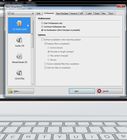How to Choose the Best Area to Stay in Navi Mumbai
When you buy a home you are also buying into the neighbourhood. That’s why it’s important to identify the wants and needs you have of your home and the location before making the commitment to home ownership. So, I am asking all you people here to help me to choose the exact Area to stay.
EditSteps
-
1Whether you are out to buy your dream home or as a real estate investment in your portfolio, it is always important to keep a check list when going about the evaluation process. Buying homes in and around Mumbai can be a complicated process and most often the devil lies in the detail. Let's try and break these down. There are a few common check boxes irrespective of location which come first:
- Conversion/ approval of land for residential development is available
- Plans: Approved construction plans are available and they match with the design being promised. Such approved plans must be displayed on the project site at all times
- Permits: The list of essential permissions and approvals required for the project is known (importantly urban/ town planning, municipal corporation, environment and forests, airports etc). Find out which of these are obtained and which are pending.
- Land: The developer has authority/power of attorney to transfer the undivided share of land to each flat owner and the entire plot to the society and/or the project on completion
- Ownership: The landowner/promoter/developer has no right on open spaces, terraces etc to provide unrestricted ownership and enjoyment of property by flat buyers.
- Access: The building has clear and approved road access, right of easement and established pathways
-
2For completed flats apart from the above:Quite often securing such detailed information, verifying and deciphering it can be quite complicated. Hence once preliminary due diligence is conducted by the buyer it becomes important to engage a good property lawyer to verify the documentation.
- Compliance: The flat has been constructed as per the approved plan
- Completion certificate has been obtained for completed buildings
- Utilities are available and connected for each flat
-
3Buyers in Mumbai have to muddle through the property maze a bit more than probably those in those other cities. Let's now delve into the parameters of buying flat in Mumbai first:
- IOD/CC: The Municipal Corporation of Greater Mumbai and Thane issue certificates called Intimation of Disapproval (IOD) and then Commencement Certificate (CC) for construction of buildings. Since development cannot commence before CC is obtained, buyers must verify this.
- Land Rights: Land in Mumbai can either be free hold or lease hold and rights transferred ancestrally (gift/inheritance) or through MHADA (Maharashtra Housing and Area Development Authority), Mumbai Port Trust, Collector of Mumbai, Railways, Airport Authority, National Textile Corporation, Slum Rehabilitation Authority (SRA), Mumbai Metropolitan Regional Development Authority (MMRDA) or other State agencies. It is important to understand the covenants that go with such ownership or rights. Eg. In SRA schemes, the rehabilitation portion needs to be completed first.
- Zone and Use: The city master plan has clear demarcated zones. However it is possible to use industrial, coastal regulation zones (CRZ) or even forest zones for residential development provided necessary permissions and approvals have been obtained and the regulations regarding such development followed. Understanding current zoning and conversion to clear residential use is very important
- Development regulations: The Development Control Regulations (DCR) governs the construction of buildings in Mumbai. The more popular schemes under DCR being applied are rules 33(7) for Grade A cessed buildings and 33
- for cluster redevelopment. These rules come with their own covenants. The buyer must understand the DCR under which the building has been constructed and the limitations/benefits under these.
- Calculation of area: In Mumbai several terms like built up, super built up, saleable, carpet areas are used to define the floor space being made available to the buyer. The difference between the carpet area (the actual area between walls in a flat) and the area sold (saleable area) is called the 'loading factor'. Maharashtra laws make it mandatory to sell flats on carpet area. Carpet area does not include the area of terraces, flower beds, balconies and car parks which are granted free from FSI computation to each building. It is hence important to understand the stated vs. the actual carpet area and the loading factor being applied. Loading factor = (Saleable area - Carpet area)/ Saleable area. This factor should generally not exceed 30%. Obviously the lower the better. The term built up area is used for the entire floor area including the wall thickness whereas super built up apportions the common areas like lift, lobby, staircase etc.
- Total Cost: While the apartments are usually quoted on basic prices, there are various other costs affiliated with a purchase which can grossly increase the total cost of ownership. Hence it is important to not get mislead with just the advertised or offer price but understand the total composition (all in all costs). Some of the elements of costs include: floor rise, car park, amenities, preferred location, infrastructure charge, and maintenance and club house. With the recent introduction of service tax on under development projects, these features would attract tax too apart from the construction cost. Hence it is important to understand the total cost of ownership, with their detailed elements, with taxes, stamp duty, registration and brokerage.
- Maintenance: Developers usually take lump sum and recurring maintenance charges till such time the building has been fully handed over to the society of owners. It is important to understand the reasons and elements of such charge and the responsibility of the developer therefore. Also understand the total recurring costs that each flat owner will need to bear towards property taxes and maintenance each year.
- List of promised features: Buildings, projects and flats are often marketed with several features. It is important to get minute details of such features, have them appear in the agreements and question on penalties related to non performance. Documentation usually allows ad hoc and unannounced changes by the developer. Hence purchase decision cannot be based only on promised features.
- Infrastructure: Projects sell based on proposed road widening, metro rail connectivity, flyover, new airport being announced, social and civil infrastructure being developed. While many of such developments may be on the anvil, being led by the promise of uncertain future projects is not prudent. Only those infrastructure developments where work has commenced or is under the developer's control and hence part of the contract can be safely assumed.
- Safety and Sustainability: The least thought of parameter, but probably the most important for the long term should be the safe and sustainable features of the building. With increasing power and water cuts, green buildings which conserve energy, regenerate waste and create a positive ecosystem are more likely to have better life, utility and lower cost of ownership in the long run. Also having better shock and earthquake resistance buildings, with higher resistance to fire, noise, air pollution along with safety features for elders and children are very important too given Mumbai weather and social environment.
- Parking: Whether the flat buyer pays separately for dedicated parking space or not, there must be ample parking space for himself and his guests in and around the building. With increasing vehicular traffic, this can become a tipping point between projects.
-
4It remains each buyer's responsibility, without being mislead by brand names and advertisements to understand each developer and project's capabilities before arriving at a buy decision. A good way is to check with the home loan companies on their interest and competitiveness in offering mortgage for each of these projects.In buying properties outside Mumbai, there are a few other things that need to be understood:
- Other agencies like CIDCO, Town Planning, District Collector and so become nodal approval agencies. Understand the process of buying, selling and transferring flats in each jurisdiction since regulations can be quite complex and expensive.
- Proper available of public utilities like water, electricity, sewerage lines, drainage, telephones and cables in the project
- Most often, land outside Mumbai is predominantly agricultural. Clear conversion certification for residential use along with ownership rights of developer is important.
- The total commute time and available infrastructure to travel to important city/town destinations will determine larger buyer's interest and appreciation of the flat
- Availability of social infrastructure around the property: Projects in areas with established educational, medical, retail and recreational facilities are likely to find more buyers and higher appreciation than an upcoming, underdeveloped location.
- Price History: Properties outside Mumbai including Navi Mumbai have experienced extreme price volatility. It is useful to analyze the price and appreciation/volatility trend of the target micro markets to predict their behaviors in the future. Stable and steady growing markets are always preferred.
We could really use your help!
movie trailers?

acupressure?

skiing?

wedding dresses?









